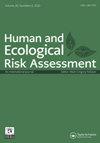DEVELOPMENT AND PILOT TESTING OF A MODEL TO TRANSLATE RISK ASSESSMENT DATA FOR GREAT LAKES NATIVE AMERICAN COMMUNITIES USING MOBILE TECHNOLOGY.
IF 2.7
3区 环境科学与生态学
Q2 ENVIRONMENTAL SCIENCES
Human and Ecological Risk Assessment
Pub Date : 2018-01-01
Epub Date: 2017-10-09
DOI:10.1080/10807039.2017.1377596
引用次数: 10
Abstract
ABSTRACT The Chippewa Ottowa Resource Authority monitors fish contaminants in Anishinaabe (Great Lake Native American) tribal fisheries. A software program (app) was programmed to translate and operationalize these data for the first time in an interactive, personalized, and culturally tailored format. This article reports the process for creation, and preliminary community reception, of interactive fish consumption advisory using software that can be accessed via mobile phones and/or the internet. Response data to previous advisories guided the app presentation and aesthetics. The app “Gigiigoo'inaan’ [Our Fish] presents personalized recommendations based on back-end calculated reference doses as well as a novel risk/benefit quantification originally presented by Ginsberg et al. (Human Ecol Risk Assess, Vol. 21, 2015, pp. 810–39) and Ginsberg and Toal (Environ Health Perspect, Vol. 117, 2009, pp. 267–75) to characterize nutritional benefits. The partnering organization, Inter-Tribal Council of Michigan recruited focus groups to pilot test the app for usability, influence on dietary behavior, and cultural appropriateness. The general concept of the app and the presentation of the data were deemed culturally acceptable and pleasing to the participants. The results suggest that risk-benefit data is valuable to end-users but meal frequency recommendations, typically based on federal guidelines, should also be clearly communicated. How these guidelines are selected and presented will likely impact the reception and adoption of consumption advice.


开发和试点测试一个模型,利用移动技术为大湖区印第安人社区转换风险评估数据。
本文章由计算机程序翻译,如有差异,请以英文原文为准。
求助全文
约1分钟内获得全文
求助全文
来源期刊

Human and Ecological Risk Assessment
环境科学-环境科学
CiteScore
9.60
自引率
2.30%
发文量
68
审稿时长
2 months
期刊介绍:
Human and Ecological Risk Assessment provides a resource for professionals researching and assessing environmental hazards to both humans and ecological systems. The editors expect papers published to be original, of sound science, purposeful for risk analysis (assessment, communication, management) and related areas, well written (in English), and a contribution to the scientific literature.
The journal''s emphasis is on publication of papers that contribute to improvements in human and ecological health. The journal is an international, fully peer-reviewed publication that publishes eight issues annually. The journal''s scope includes scientific and technical information and critical analysis in the following areas:
-Quantitative Risk Assessment-
Comparative Risk Assessment-
Integrated Human & Ecological Risk Assessment-
Risk Assessment Applications to Human & Ecosystems Health-
Exposure Assessment-
Environmental Fate Assessment-
Multi-Media Assessment-
Hazard Assessment-
Environmental Epidemiology-
Statistical Models and Methods-
Methods Development/Improvement-
Toxicokinetics Modeling-
Animal to Human Extrapolation-
Risk Perception/Communication-
Risk Management-
Regulatory Issues
 求助内容:
求助内容: 应助结果提醒方式:
应助结果提醒方式:


